Ijraset Journal For Research in Applied Science and Engineering Technology
- Home / Ijraset
- On This Page
- Abstract
- Introduction
- Conclusion
- References
- Copyright
Development of Choco Dates Chocolates
Authors: Vaishnavi Nilesh Gampawar, Mitali Sanjay Rahate, Utkarsha Jayprakash Lade, Bharatsingh Shivshankar Azad, Prof. Divya Korde, Prof. Prashant Watkar
DOI Link: https://doi.org/10.22214/ijraset.2024.61803
Certificate: View Certificate
Abstract
Layers of Rich Chocolate Contrasted with the Nutrient Rich Goodness of Dates Experience the unique blend of flavors as whole dates are delicately roasted, seeds removed with a small cut, and filled with luscious creamy rasmalai chocolate. Each piece is then generously coated in melted dark chocolate. Surprisingly, you only need 5 ingredients to craft these delectable treats, and they\'re not just delicious they\'re vegan and gluten free too. What sets these date chocolates apart is the protein-laden sweetness inherent in dates, enhancing the overall flavor profile. Elevate your taste experience with this health conscious and satisfying chocolate creation. A chocolate flavored with whole date was prepared by using white 32% and dark compound 20% and 45% of dates and 1.76 g of essence. The chocolates were prepared with natural dates sweetness. Both chocolates are melted (white compound at 42-45°C)and (dark compound at 50- 55°C) mixed with a essence for 2 min, and Cooling Down at room temperature for 2 min for settle down, then filling and cover the dates with fusion chocolates and Choco dates Chocolates is prepared.[Ahmed M. Hamad et al.,1987]
Introduction
I. INTRODUCTION
One of the world's most beloved food types and flavors is chocolate, with a multitude of chocolate-infused foodstuffs gracing our tables. Desserts, ranging from cakes, pudding, and mousse to delectable treats like chocolate brownies and chocolate chip cookies, showcase the versatility of this delectable ingredient. Confections like candies often boast sweetened chocolate fillings or coatings. Whether in the form of solid chocolate bars or as a delightful covering for other ingredients, chocolate is a go-to snack for many.
Traditional Western holidays, including Christmas, Easter, Valentine's Day, and Hanukkah, witness the exchange of chocolate gifts molded into various shapes such as eggs, hearts, and coins. Beyond solid forms, chocolates plays a role in both cold and hot beverages, adding its rich flavors to classic like chocolate milk and hot chocolates, and even finding its way into some alcoholic concoctions, like cream de cacao. [Mesoamerican Luxury 2011]. The indulgence in chocolate, a widely cherished food, has always been intertwined with feelings of enjoyment and pleasure. The longstanding recognition of chocolate's impact on mood adds another layer to its allure. This delicacy is believed to engage with neurotransmitters, playing a role in modulating mood and regulating appetite. Despite these intriguing possibilities, the evidence stemming from studies exploring the nexus of chocolate and mood remains shrouded in controversy. As our comprehension of the connection between chocolate and mood deepens, the intricacies and interconnections underlying these effects become progressively complex and entwined.[Malaysian journal of nutrition 17 (2), 2011]
II. MATERIALS AND METHODOLOGY
This chapter contains all the materials and methodology followed to prepare and test the product. The test method for testing raw materials and product are also discussed. New product development work was carried out at the Department of Food Technology, Ballarpur Institute of Technology, Bamni, Ballarpur.
Table 1: Material Required for New Product Development
|
Material Required |
Collection of Raw Material |
|
Dates |
Jio mart |
|
White compound |
Super market |
|
Dark compound |
Super market |
|
Butter |
Super market |
|
Essence |
Super market |
|
Chocolate mold |
Home |
|
Parachment paper |
Home |
|
Microwave |
Processing lab |
|
Refrigerator |
Processing lab |
|
Measuring cups |
Processing lab |
|
Induction |
Processing lab |
|
Spatula |
Processing lab |
|
Weighing machine |
Processing lab |
|
Knife |
Processing lab |
- Packaging Material: Transparent plastic trays, often used to showcase the assortment of chocolates, provide a clear view of the tempting treats nestled within. The trays are designed to cradle each piece of chocolate securely, maintaining their shape and integrity during storage and transportation. The silver-colored foil wrapper adds a touch of elegance and sophistication to the packaging, hinting at the indulgent delights awaiting inside. Silver foil not only protects the chocolate from external factors like moisture and light but also enhances its aesthetic appeal, making it visually enticing to consumers. Each chocolate is further adorned with its own colorful wrapper, adding a playful pop of color to the ensemble. Together, these elements create a visually appealing presentation that entices chocolate lovers to unwrap and savor each delectable piece.

2. Methodology:
Ingredient selection: high quality dates along with complementary ingredients such as dark compound, white compound, butter, essence to achieve optimal taste.
Flow sheet of preparation of Choco Dates Chocolates:
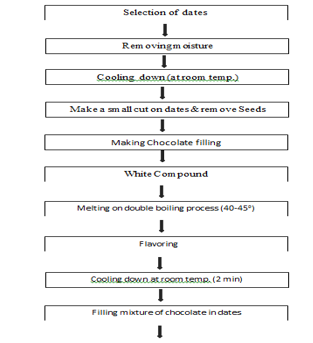
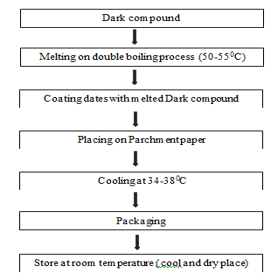
Sensory Analysis: : Sensory analysis was conducted in the campus of Ballarpur Institute of Technology by a sensory panel consisting of 10 panelists. The panelist observed color, appearance, flavor, texture, taste and overall acceptability of product and rated them in a scale of 0 to 10 with 0 as the minimum and 10 as the maximum.
3. Proximate Analysis:
Estimation of Moisture
Moisture content was determined using the Oven drying method. Approximately 5 grams of the sample were weighed (W2) on pre-weighed petri plates (WI) and placed in an oven 105" C for 3 hours. After drying, the samples were cooled in airtight desiccators to prevent moisture exchange with the environment. The drying process was considered complete when two consecutive weighings, taken an hour apart, showed variations of no more than 5 mg. Moisture content was calculated by subtracting the dried weight from the initial sample weight and expressed as a percentage.[Adya Yadav, et al, 2016]
%Moisture= (Loss in weight x 100)/ (weight of sample)
Estimation of fat:
5 gm sample was weighed and packed in a thimble the prepared thimble was weighed to cross check the weight of the sample. The thimble was then enclosed in a big cellulose thimble and then it was placed in a Soxhlet extraction tube, 250 ml, of petroleum ether, was added to the Soxhlet extraction tube containing the sample. The heating mantle was turned on and the temperature was set at 60°C. Petroleum ether gets evaporated and condensed and falls over the sample drop by drop and the speed of dropping should be 150 drops per minute. When clear color petroleum ether seen in Soxhlet after 6-12 hours, the assembly was turned off. The round bottom flask containing the solvent was separated from the assembly to recover the solvent. The solvent was recollected by using the downward distillation unit for the next use and the round bottom flask holding the extracted fat sample was dried in a hut air oven at 105 "C until all the solvent was removed after drying the RBF was cooled in a desiccator and the weight was taken until the last three successive reading shows the difference less than 0.001 gm. . A 5- gram sample underwent initial weighing and was then enclosed within a thimble. Subsequently, the thimble, now containing the sample, underwent an additional weighing to verify the sample's weight. The thimble, housing the sample, was then inserted into a larger cellulose thimble. This combined setup was carefully positioned within a Soxhlet extraction tube. To facilitate the e extraction process, 250 ml of petroleum ether introduced into the Soxhlet extraction tube containing the sample. Upon activating the heating mantle and setting the temperature to 60°C, the petroleum ether underwent a cycle of evaporation, condensation, and dripping over the sample at a controlled rate of 150 drops per min Once the petroleum ether, now visibly clear, was observed in the Soxhlet after 6-12 hours, the entire assembly was deactivated. . The round bottom flask, holding the solvent, was then separated from the apparatus to recover the solvent..
The reclaimed solvent underwent further processing using a downward distillation unit for subsequent use. Meanwhile, the round bottom flask containing the extracted fat sample underwent a drying process in a hot air oven set at 105°C until all the solvent was completely removed. Following drying, the round bottom flask was cooled in a desiccator, and its weight was measured until three successive readings showed a difference of less than 0.001 grams [AOAC(1995)]. Percent crude fat calculated as under:
% Crude Fat= (weight of fat)/(weight of sample) x100
Estimation of protein:
The protein content of the samples was determined utilizing the Kjeldahl method. Initially, 2 grams of the sample underwent digestion with 5 grams of a digestion mixture, comprising 10 parts potassium sulfate and I part copper sulfate, along with 20 ml of concentrated sulfuric acid. This digestion process continued in a Kjeldahl flask until the contents achieved a state of being carbon- free. The resulting digested sample was then adjusted to a final volume of 100 ml. A 10 ml aliquot of the digested sample was subjected to distillation with 20 ml of 30 percent sodium hydroxide. The liberated ammonia from this process was collected in a solution containing 20 ml of 2 percent boric acid, enriched with 2-3 drops of a mixed indicator. This indicator was a combination of 0.1% methyl red and 0.1% bromo-cresol green, dissolved in 95 percent ethyl alcohol, with a ratio of 1:5, respectively. The entrapped ammonia was subsequently titrated against 0.IN hydrochloric acid. The nitrogen content in the sample was then calculated using the following expression:
% Nitrogen (14xN of HCL x Titre value (ml)× Dilution factorx100)/(Weight of sample (g)x100)
Estimation of Total Ash:
To determine the ash content, a 2-gram sample was placed in a silica crucible and ignited on a heater. Subsequently, the crucible was transferred to a muftle furnace and maintained at a temperature of 550° C 15° C until a clean ash was obtained. The weight of the resulting residue was then recorded, and the percentage of ash was calculated using the following formula:
%Ash = (weight of residue x 100)/(weight of sample)
Estimation of carbohydrates:
The percent carbohydrates were calculated by subtracting the sum of moisture, protein, fat, ash and fiber from 100.
% CHO 100-(% Moisture +% Protein+% Fiber+%+ Ash
Microbial Analysis:
The Total bacterial count and fungal load was estimated by serial dilution method.
Shelf life testing:
Shelf life was estimated based on microbial and sensory analysis at intervals of 5 months.
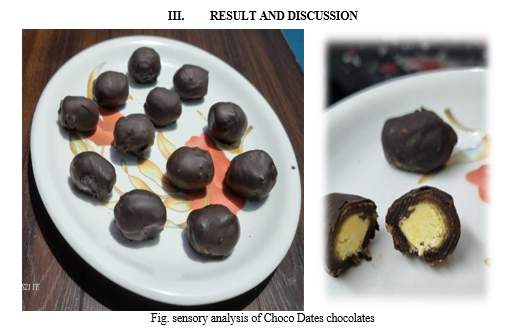
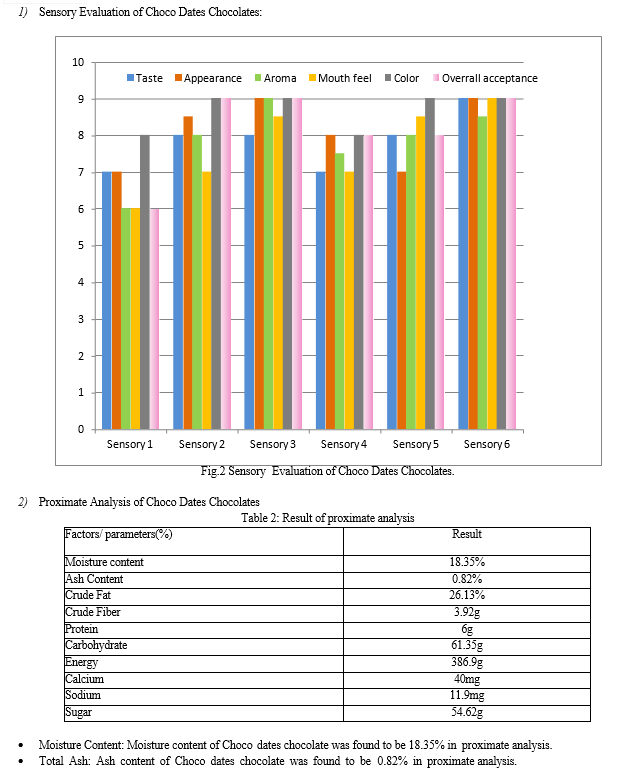
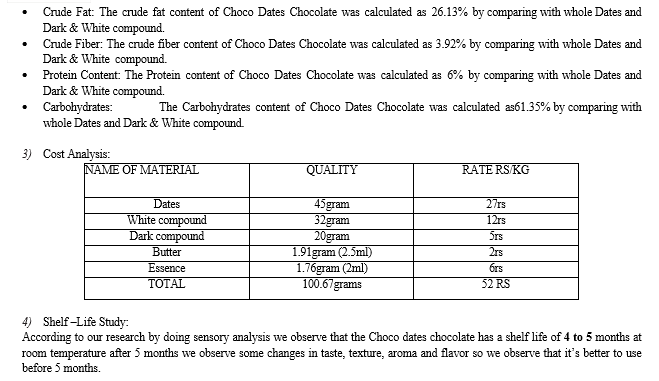
Conclusion
In conclusion, the choco dates chocolate is a delectable treat that combines the natural sweetness of dates with the rich flavors of dark and white compound chocolate. The addition of rasmalai essence enhances the overall taste, adding a unique and delightful twist to the traditional chocolate experience. The inclusion of butter contributes to a smooth and velvety texture, creating a satisfying mouthfeel. This fusion of ingredients results in a well-balanced and indulgent chocolate that not only satisfies sweet cravings but also offers a sophisticated flavor profile. The combination of natural sweetness, chocolate richness, and the aromatic essence makes the choco dates chocolate a delightful and memorable treat for chocolate enthusiasts. Enjoy the harmonious blend of textures and flavors in every bite of this decadent creation.
References
[1] Malaysian journal of nutrition 17 (2), 2011 Wong SY, Lua PL [2] Sami Ghnimi Binaifer Bedford, Ye Yu, Xue Wang, Eric AE Garber, Lauren S JacksonJournal offoodprotection80(4),2019 [3] 3 .SulaimanAljaloud, Heather L Colleran, Salam A Ibrahim Food and NutritionSciences 11(06), 463, 2020. [4] John Wiley & Sons, 2016 Emmanuel Ohene Afoakwa John Wiley & Sons, 2016 [5] Meredith L Dreiss, Sharon Greenhill, 2008 [6] Abdul Fateh Hosseini, Mostafa Mazaheri?Tehrani, Samira Yeganehzad, Seyed Mohammad Ali Razavi [7] Food Science & Nutrition 9 (3), 1432-1440, 2021 [8] Fisher ND, Hughes M, Gerhard-Herman M, Hollenberg NK. Flavanol-rich cocoa induces nitric-oxide-dependent vasodilation in healthy humans. J Hypertens. 2003;21:2281-6 [9] Engler MB, Engler MM, Chen CY, et al. Flavonoid-rich dark chocolate improves endothelial function and increases plasma epicatechin concentrations in healthy adults. J Am CollNutr. 2004;23:197-204. [10] Grassi D, Desideri G, Mai F, et al. Cocoa, glucose tolerance, and insulin signaling: cardiometabolic protection. J Agric Food Chem. 2015;63:9919-26. [11] Hooper L, Kay C, Abdelhamid A, et al. Effects of chocolate, cocoa, and flavan-3-ols on cardiovascular health: a systematic review and meta-analysis of randomized trials. Am J ClinNutr. 2012;95:740-51. [12] Hollenberg NK, Fisher ND, McCullough ML. Flavanols, the Kuna, cocoa consumption, and nitric oxide. J Am SocHypertens. 2009;3:105-12
Copyright
Copyright © 2024 Vaishnavi Nilesh Gampawar, Mitali Sanjay Rahate, Utkarsha Jayprakash Lade, Bharatsingh Shivshankar Azad, Prof. Divya Korde, Prof. Prashant Watkar. This is an open access article distributed under the Creative Commons Attribution License, which permits unrestricted use, distribution, and reproduction in any medium, provided the original work is properly cited.

Download Paper
Paper Id : IJRASET61803
Publish Date : 2024-05-08
ISSN : 2321-9653
Publisher Name : IJRASET
DOI Link : Click Here
 Submit Paper Online
Submit Paper Online

